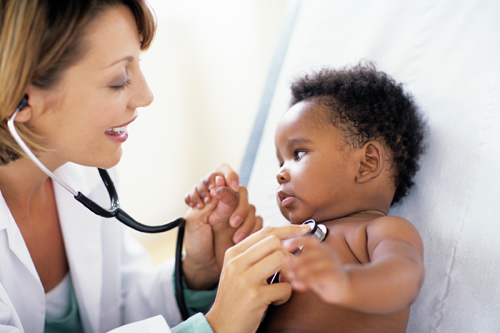Don't bug me

There’s nothing worse than a sick baby, and parents everywhere […]
There’s nothing worse than a sick baby, and parents everywhere should be informed of the dangers of airborne viruses. Two of the most common culprits are influenza (flu) and respiratory syncytial virus (RSV). Though both are well known to (and oft experienced by) adults, each can pose huge threats to young babies. Follow these tips to safeguard your baby from unwelcome germs.

“In the U.S., the flu season is really October through March or April, and the peak is usually February,” says Kevin Ault, MD, associate professor of obstetrics and gynecology at Emory University School of Medicine in Atlanta and medical adviser to the national nonprofit organization Families Fighting Flu. Infected persons can pass influenza through the air easily when coughing or sneezing, and since symptoms sometimes resemble the common cold, they may unknowingly spread the virus to others. Babies who partake in social activities such as playdates, school or daycare, or who interact with older siblings need to be especially careful in terms of exposure.
The first symptom of the flu is usually a sudden onset of fever (typically 101°F or higher). But unlike adults, Ault explains, baby can get fevers for a whole slew of other reasons, so a high temperature isn’t necessarily a telltale sign. However, if the fever is accompanied by fatigue, chills, abdominal pain, lack of appetite, respiratory problems, cold symptoms, a sore throat, swollen glands, diarrhea, vomiting or a dry cough, then it’s definitely time to head to your pediatrician. While older children may be able to treat the flu at home, babies under age 2 are at serious risk for dehydration, respiratory issues and other bacterial infections like pneumonia and may require hospitalization.
If your baby catches this bummer of a bug, make sure to keep her extra hydrated by offering plenty of breast milk or formula and check with your doctor about offering an appropriate dose of a pain reliever such as acetaminophen. Your tot should be feel- ing better in a few days and symptoms should completely dissipate within two weeks.
RSV
According to the Centers for Disease Control and Prevention (CDC), almost all children will have had a bout with RSV by their second birthday. The respiratory virus infects the lungs and breathing passages, and it’s the most common cause of bronchiolitis (inflammation of the small airways in the lung) and pneumonia in children under 1 year of age in the U.S. Prevalent in fall, winter and early spring, RSV is highly contagious and usually brought into the home by an older school-age child with a respiratory infection. “RSV can be rapidly transmitted to other members of the family, often infecting about 50 percent of other household members,” according to the CDC. Much like the flu, RSV is passed through the air by sneezing or coughing; it can take four to six days to come down with symptoms.
In most healthy babies, the virus will surface as a cold (symptoms include runny nose, low-grade fever and decreased appetite), but in certain high risk groups, the illness can cause additional problems. This group includes premature infants, babies with immune system deficiencies, and those with heart and lung problems. Be on the lookout for wheezing, irritability, fever, blue skin, decreased activity and breathing difficulties—all of which signal a need for immediate medical attention.
If your babe comes down with RSV, seek advice from your pediatrician so she can assess the severity of the virus. Most healthy babies can fight the infection at home with treatments such as saline drops, a cool mist humidifier and the appropriate dose of pain reliever; others in the high risk category may need to be hospitalized. In severe cases, babies may require oxygen, suctioning of mucus from the airways, and intubation with mechanical ventilation. Regardless, your little one should be recovered in one to two weeks.
Prevention
Every mom knows a thing or two about germ prevention, and the same rules apply when it comes to the flu or RSV. Avoid the flu with the tried-and-true strategies your grandmother taught you: Wash your hands and avoid public places and congested areas. The same goes for RSV. “Plain old hand washing is the best defense you have,” confirms Ault. Moms have to be proactive about washing their own hands, encourage other family members to do the same, and take initiative to wash baby’s hands with soap and water, a task that is easily forgotten. Since germs can live on hard surfaces for several hours, it’s important to be as clean as possible in the home. It’s also wise not to share cups or utensils with other parties.
When it comes to the flu, there’s another highly effective form of defense: the flu shot. The benefits of the shot start even before a baby is born. The vaccine is critical during pregnancy to both mom and baby, since studies show that expectant women are six times more likely to be severely affected by the flu with effects ranging from maternal death to the development of schizophrenia and autism in the fetus, shares Ault.
But protection doesn’t last only during pregnancy. “Not only are babies [whose mothers receive the vaccine] bigger, they are more protected against the flu through the first few months of life,” says Ault. “The mom makes antibodies, and the antibodies are passed down to the baby. Babies younger than 6 months can’t get the flu shot so it’s vitally important to get vaccinated during pregnancy so the antibodies can pass through.” Once a tot hits the 6-month mark, he can receive his own flu shot, and Ault recommends every member of the family receive a flu shot annually. Since different strains of the flu pop up each year, last year’s flu shot won’t protect against this year’s virus.
Though there is currently no vaccine to prevent RSV, a drug called palivizumab can be used to prevent severe RSV illness in certain infants and children who are at high risk, but it cannot cure or treat children already suffering from serious RSV nor can it prevent infection.







